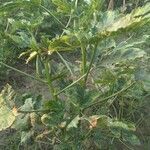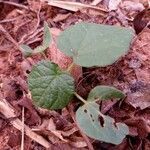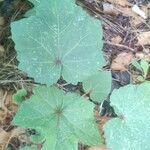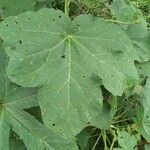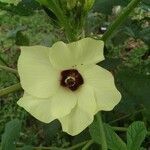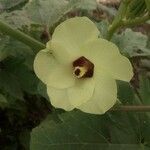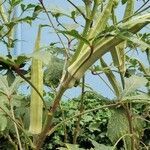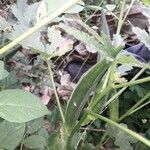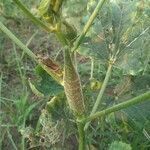Herbs annual, 1-2 m tall, most parts with very sparse prickly hairs. Stem often hollow. Stipule filiform, 7-10 mm, sparsely hirsute; petiole 7-15(-35) cm, long hirsute, often with pubescent adaxial groove; leaf blade palmately 3-7-lobed, (5-)10-30 cm in diam., lobes broad to narrow, sparsely hirsute on both surfaces, margin sparsely dentate and emarginate. Flowers solitary, axillary. Pedicel (0.5-)1-2(-5) cm, sparsely strigose. Epicalyx lobes 7-10(-12), filiform, 5-18 × 1-2.5 mm, sparsely hirsute. Calyx campanulate, 2-3 cm, densely stellate puberulent. Corolla yellow or white with dark purple center, 5-7 cm in diam.; petals obovate, 3.5-5 × 3-4 cm. Filament tube 2-2.5 cm. Capsule cylindric to tower-shaped, 10-25 × 1.5-2(-3) cm, long beaked, sparsely strigose. Seeds dark brown or gray, globose to reniform, 5-15 per locule, (3-)4-5(-6) mm, striate, minutely warty. Fl. May-Sep.
A tropical annual herb. It grows erect, often with hairy stems. It mostly grows about 1 m tall but can be 3.5 m tall. It becomes woody at the base. The leaves have long stalks up to 30 cm long. Leaves vary in shape but are roughly heart shaped with lobes and teeth along the edge. Upper leaves are more deeply divided than lower ones. The flowers are yellow with red hearts. The fruits are green, long and ribbed. They have 5-7 ribs. They are 7.5-15 cm long. The seeds are 4-5 mm across. They are round and dark green. Many varieties exist.
Plants 1–2 m. Stems often red blotched, coarse. Leaf blades scarcely lobed to palmately divided, 10–25 cm, ± broader than long. Pedicels not articulated, stout; involucellar bractlets linear, to 2.5 cm. Flowers: corolla to 8 cm diam.; staminal column anther-bearing from near base, apex 5-toothed. Capsules cylindric, slightly 5-angled, beaked, 8–30 cm. 2n = 72, 108, 118, 120, 122, 130, 132, 144.
Leaf-lamina up to 25 × 25 cm., suborbicular in outline, palmatifid,-lobed or-sect, sparsely to densely setulose or setose-pilose on both surfaces especially on the nerves, margins serrate, base cuneate to cordate; petiole up to 30 cm. long; stipules up to 15 mm. long, filiform, densely pilose.
Seeds 5 × 4 mm., depressed-globose, slightly humped, with concentric lines of minute stellate hairs or scales and sometimes pilose.
Capsule up to 14 cm. long, ellipsoid to very narrowly ellipsoid, at first appressed-setose and pubescent, later glabrescent.
Flowers up to 8 cm. in diam., yellow with purple centre; peduncle 1–4 cm. long, stout, thickened in fruit.
Epicalyx of 10–12 bracts; bracts up to 25 × 2·5 mm., narrowly linear-triangular, caducous.
Staminal tube 12–20 mm. long; free parts of filaments up to 0·5 mm. long.
Annual herb up to 2 m. tall; stems succulent, setulose.
Style projecting up to 1 mm. beyond the staminal tube.
Calyx 3–4 cm. long, with 5 short linear teeth.
Petals up to 7–8 cm. long.
